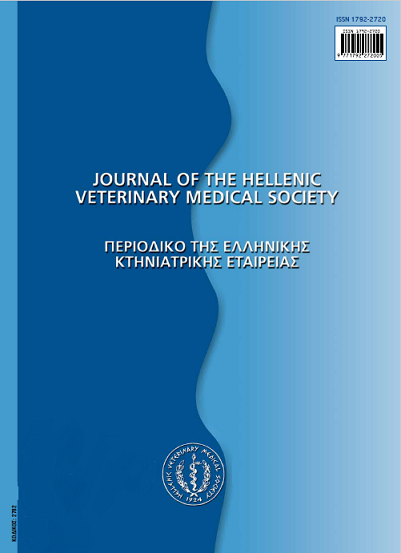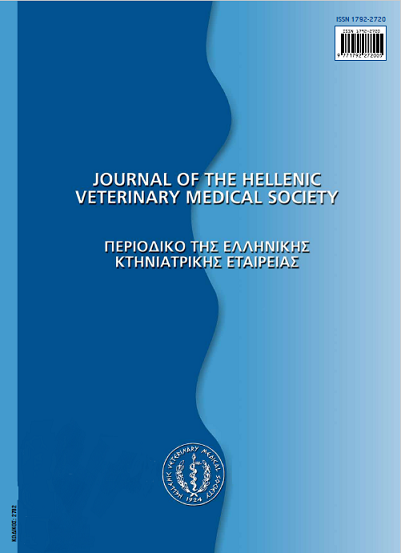To σύνδρομο της δερματίτιδας από λείξη των άκρων στο σκύλο
Аннотация
To σύνδρομο της δερματίτιδας από λείξη των άκρων σε σκύλους είναι ένα από τα πιο περίπλοκα δερματολογικά προβλήματα, που καλείται να αντιμετωπίσει ο κτηνίατρος στην καθημερινή πράξη. Οι δερματικές αλλοιώσεις είναι το αποτέλεσμα της επίμονης λείξης κάποιας συγκεκριμένης περιοχής, συνήθως στην πρόσθια επιφάνεια του κατώτερου τμήματος των άκρων, που προοδευτικά οδηγεί στο σχηματισμό πλάκας ή οζιδίου με αλωπεκία, ερύθημα, υπερχρωμία, εξίδρωση, διαβρώσεις, έλκη και πάχυνση του δέρματος. Η δερματοπάθεια εμφανίζεται συχνότερα σε αρσενικούς σκύλους μεγαλόσωμων φυλών, συνιστώντας δερματολογικό σύνδρομο πολυπαραγοντικής αιτιολογίας.
Συγκεκριμένα, στην αιτιοπαθογένεια του προβλήματος υπεισέρχονται διάφορα οργανικά (π.χ. κνησμώδεις δερματοπάθειες, επώδυνες παθολογικές καταστάσεις) και ψυχογενή αίτια. Στα πρώτα, περιλαμβάνονται κυρίως η εν τω βάθει βακτηριακή δερματίτιδα, η ατοπική δερματίτιδα, η τροφική αλλεργία, τα ξένα σώματα, οι αισθητικές νευροπάθειες και οι επώδυνες παθολογικές καταστάσεις των υποκείμενων οστών και αρθρώσεων. Η ψυχογενής δερματίτιδα από λείξη μπορεί να είναι πρωτογενής (άγχος, ανία, αναζήτηση προσοχής του ιδιοκτήτη, στερεοτυπική συμπεριφορά) ή ψυχοσωματική διαταραχή της συμπεριφοράς. Πάντως, δεν είναι σπάνια τα περιστατικά, στα οποία συνυπάρχουν περισσότερα από ένα αίτια, όπως και το γεγονός ότι η εν τω βάθει βακτηριακή δερματίτιδα, εκτός από οργανικό αίτιο, αποτελεί τη συχνότερη επιπλοκή των αλλοιώσεων της ψυχογενούς μορφής της δερματίτιδας αυτής, καθώς διαπιστώνεται στο σύνολο σχεδόν των περιστατικών. Η διάγνωση του συνδρόμου στηρίζεται στην κλινική εικόνα και τον αποκλεισμό των δερματοπαθειών εκείνων που μπορούν να προκαλέσουν παρόμοιες αλλοιώσεις (π.χ. μολυσματικό κηρίο, δεμοδήκωση, λεϊσμανίωση, άσηπτα κοκκιώματα των άκρων, νεοπλάσματα). Για την ανεύρεση του υποκείμενου αιτίου, απαιτείται η πραγματοποίηση σειράς διαγνωστικών εξετάσεων, που διαφέρουν ανάλογα με το περιστατικό, στις οποίες περιλαμβάνονται η κυτταρολογική, η μικροβιολογική και η ιστοπαθολογική εξέταση, τα ακτινογραφήματα της περιοχής και η δοκιμαστική χορήγηση υποαλλεργικής τροφής. Διάγνωση της ψυχογενούς μορφής της δερματίδας αυτής πρέπει να τίθεται μόνον εφόσον αποκλειστούν τα οργανικά αίτια και η επίμονη λείξη εξακολουθεί να παραμένει μετά τη θεραπεία της εν τω βάθει βακτηριακής δερματίτιδας.
Η θεραπευτική αγωγή, ανεξάρτητα από το υποκείμενο αίτιο, περιλαμβάνει μεθόδους συγκράτησης και τη μακροχρόνια συστηματική χορήγηση, ενδεχομένως δε και τοπική, αντιμικροβιακών ουσιών, κατά προτίμηση ύστερα από πραγματοποίηση βακτηριολογικών εξετάσεων. Στην οργανική μορφή της νόσου, πρέπει να ακολουθείται η κατάλληλη κατά περίπτωση αγωγή, ενώ στην ψυχογενή επιχειρείται η απομάκρυνση του αιτίου και των εναυσματικών παραγόντων, η απευαισθητοποίηση και η ανάπτυξη αντισταθμιστικής συμπεριφοράς και η χορήγηση ψυχοτρόπων φαρμάκων. Επικουρικά ή όταν τα παραπάνω αποτύχουν, μπορεί να βοηθήσουν η τοπική αγωγή με γλυκοκορτικοειδή, διμεθυλσουλφοξείδιο (DMSO), καψαϊκίνη ή τακρόλιμο, η κρυοχειρουργική, η χειρουργική με laser, ο βελονισμός και η ακτινοθεραπεία.
Article Details
- Как цитировать
-
GIANNOULOPOULOS (Γ.Δ. ΓΙΑΝΝΟΥΛΟΠΟΥΛΟΣ) G. D., & SARIDOMICHELAKIS (Μ.Δ. ΣΑΡΙΔΟΜΙΧΕΛΑΚΗΣ) M. N. (2017). To σύνδρομο της δερματίτιδας από λείξη των άκρων στο σκύλο. Journal of the Hellenic Veterinary Medical Society, 63(3), 227–244. https://doi.org/10.12681/jhvms.15438
- Выпуск
- Том 63 № 3 (2012)
- Раздел
- Review Articles
Authors who publish with this journal agree to the following terms:
· Authors retain copyright and grant the journal right of first publication with the work simultaneously licensed under a Creative Commons Attribution Non-Commercial License that allows others to share the work with an acknowledgement of the work's authorship and initial publication in this journal.
· Authors are able to enter into separate, additional contractual arrangements for the non-exclusive distribution of the journal's published version of the work (e.g. post it to an institutional repository or publish it in a book), with an acknowledgement of its initial publication in this journal.
· Authors are permitted and encouraged to post their work online (preferably in institutional repositories or on their website) prior to and during the submission process, as it can lead to productive exchanges, as well as earlier and greater citation of published work.





